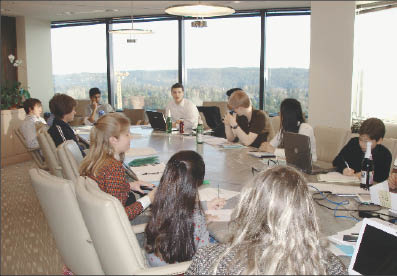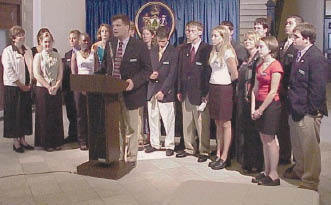While youth workers might see the value of seeking youth input on government policy as a no-brainer, the practice of developing youth advisory bodies for state legislatures and agencies has only recently begun to take hold. The number of councils and cabinets composed of youth has grown in recent years – but they are often on shaky ground, and it is difficult to gauge their success.
 |
|
A place at their own table: A meeting of Washington’s state Legislative Youth Advisory Council.
Photo: Courtesy of Washington LYCAC
|
Some 140 local youth councils exist in 19 states and Washington, D.C., according to a recent report by the Washington-based Forum for Youth Investment (FYI). At least 10 states have state-level councils, although one of the grander experiments – the governor’s Youth Cabinet in Missouri – faded out of existence in 2005.
Developing a youth council is one thing; the especially difficult work is keeping it going and getting policymakers to pay attention. “Staffing and funding are the biggest issues,” says Thaddeus Ferber, program director for FYI.
The first such council was established in North Carolina in 1970, according to the FYI report, “Building Effective Youth Councils.” Most of the others have been created in the past few years.
Among the six keys to success identified in the report are securing long-term funding and support and establishing access for youth to public officials. Those were the biggest challenges to the state youth councils reviewed here.
Getting state funding for staff is especially difficult, says Judy Best, coordinator for the Washington State Senate Civic Education Program. Washington has only one half-time staff person officially engaged and funded to help its Legislative Youth Advisory Council, which Best works with regularly. “You need at least one person to organize this thing across the state,” she says.
Another challenge is keeping the young people interested. Quentin Wilson, former director of the Missouri Youth Cabinet, says the adult staff members must remain vigilant about recruiting, because the youth members quickly age out of the job.
New Mexico, for instance, has had a difficult time keeping its council at full strength, in part because it has so many slots: 112, making it the largest in the nation. On the other hand, the size of the council and its efforts to recruit nontraditional participants, such as foster youth and homeless teenagers, has given it greater diversity.
Best says the members “should apply, rather than be appointed, because that means they’re more interested.” (At some councils, elected officials appoint the members.)
The adults involved with the councils have to remain involved as well. The Missouri cabinet had youth representatives serving in each of the state agencies; former member Justin Stephan says it was difficult to make sure the head of each department was willing to communicate with the youth assigned to that department.
The Maine Legislative Youth Advisory Council nearly expired in its second year (2003), when the Legislature cut its funding from two years to one. The Muskie School of Public Service at the University of Southern Maine reluctantly picked up the tab for the council that year. Then in 2004, the Maine Legislature passed a law allowing the council to be funded and staffed by the Office for Policy and Legal Research.
One key to success, says Best in Washington, is attracting a diverse group of youth. It’s easy to build a council made up only of youth who are incredibly interested in government and political careers and who are already active in civic matters. In Washington, where Best works with the Legislative Youth Advisory Council, members come from various interest groups and backgrounds; one member is from a group home. In North Carolina, the State Youth Council networks with such organizations as the NAACP and Hispanic youth groups in order to recruit more diverse representatives.
As seen on the following pages, most state youth advisory bodies don’t claim to have passed a lot of legislation. (In Maine, the council does draft legislation.)
Those involved say the councils’ achievements can’t be measured by that yardstick alone; they say they succeed whenever lawmakers and agency heads listen to the youths and learn from them.
In Missouri, Wilson believes one of the biggest benefits of youth councils is in their approach to positive youth development. “A youth council doesn’t focus so much on preventing bad outcomes as promoting good ones,” he says. He says it means a lot for kids to have a say about issues on which governments spend hundreds of millions of dollars.
Ferber of FYI says he knows of no long-term studies about the impact of youth councils on their participants.
Elizabeth Gaines, FYI program manager, says youth councils can have a huge impact on adults: “Whenever legislators get around bright young people, it’s really an education for the adults as well.”
Marta Dehmlow contributed to this report.
Creating Effective Youth Councils
Summarized from “Building Effective Youth Councils,” by the Forum for Youth Investment. The report can be found at http://www.forumfyi.org, under “publications,” then “ browse by topic,” then “youth action.”
1. Consider council membership carefully, creating councils of manageable size and workable age groups. Consider how council members will be recruited.
2. Institutionalize the council, secure long-term funding and give it a permanent physical home in a government structure.
3. Build a support network for the council by hiring staff to help it function, planning regular face-to-face meetings, using technology to connect young people with one another and with government officials, and making sure members have a strong base of support in their hometowns.
4. Train youth members; give them opportunities to engage in youth-adult teamwork and real-life policy and governing situations.
5. Help young people stay motivated by teaching them how to create change while ensuring they understand that change takes time. Make sure they set realistic goals and understand the methods for helping to change policies.
6. Give council members opportunities for access to adult leaders and for engagement with their peers and the community at large.
New Mexico Youth Alliance
Albuquerque, N.M.
(505) 821-3574
http://www.nmforumforyouth.org
The Approach: The New Mexico Youth Alliance is the largest state youth advisory body in the country. It meets three or four times a year for workshops and training, and to develop platforms on such issues as teen pregnancy and education. The goal of an issue platform is to get legislation passed, says Lanny Leyba, who until recently was project director for the alliance.
This year, the alliance is focusing on educating state agencies and the New Mexico Legislature about the degree of youth violence in New Mexico, and developing violence prevention policies for local school districts, tribal entities, cities and municipalities.
The youths try to influence legislation, policy and budget decisions by meeting with the governor’s youth cabinet, which is composed of representatives from state agencies that oversee youth-related programs. The youth meet individually with their own state legislators once or twice a year to try to influence them to take action on the alliance’s main platform issue. Leyba says the alliance has not helped to pass any legislation this year.
The alliance also conducts an annual Community Impact Project, which in 2006 was an assembly called LIFE, designed to help prevent teen suicide. This year’s project will focus on pregnancy, immigration and driver safety. The group also conducts an annual youth survey. The 2006 survey, based on 300 responses, found that young people were most concerned about teen suicide, violence, drug use and teen pregnancy.
History and Organization: Gov. Bill Richardson (D) and Lt. Gov. Diane Denish (D) included the youth alliance in their election platform in 2002, Leyba says. The Youth Council Act of 2003 established the alliance, which is a partnership between the state government and the nonprofit New Mexico Forum for Youth in Community.
One advantage of establishing the alliance in state law is that it will exist beyond Richardson’s term in office.
Youth Served: The alliance is composed of one youth (ages 14 to 24) from each of New Mexico’s 112 legislative districts. Most are recommended by school counselors and administrators, legislators or members of state departments. Youths must be nominated and go through an interview process, usually with the project director, who makes the ultimate decision about who serves.
While the council’s size allows great diversity among participants, it presents challenges. The alliance has difficulty recruiting enough members and keeping them engaged. The members don’t get much face-to-face contact, and getting everyone to meetings is difficult.
Staff: Project Director Lauren Arias.
Funding: The alliance’s annual budget is $150,000, with the state Children, Youth and Families Department providing 70 percent, Leyba says. Other funders include the New Mexico Community Foundation and some private donors.
Covering costs is still a challenge. Leyba says that to get kids to quarterly meetings, he sometimes asked for free use of vans or buses from transportation companies, or he picked up the youths himself.
Indicators of Success: In 2005 the alliance helped to initiate the state’s Next Generation Fund, a law that increased the number of after-school programs that get money through the state’s tobacco settlement fund. The alliance also helped create new statewide nutrition guidelines for schools in 2005.
Missouri’s Youth Cabinet
_fmt.jpg) |
|
High hopes: Governor Holden announces the formation of the youth cabinet at a 4-H meeting in 2001.
Photo: Courtesy of Washington LYCAC
|
St. Louis, Mo.
(314) 968-7423
The Approach: Unlike the more common youth councils that have youths serving in an advisory role to members of state Legislature, this cabinet was devised to place youths in the state’s various departments as advisers to staff and directors. “I wanted young people actively involved, not just getting coffee,” says Bob Holden (D), who served as governor from 2001 to 2005. Youths got a firsthand opportunity to see the types of issues each department faces and to work on legislation that could go to the General Assembly.
“What really was the whole point were the relationships between students and directors, the upper-level staff in each department,” says Ben Smilowitz, former coordinator of the youth cabinet.
Department heads often let youth members accompany them to full cabinet meetings in the governor’s office, where students could function as advisers.
History and Organization: After taking office in 2001, Holden launched the cabinet because he wanted to involve young people with state government in a way that “wouldn’t just be on paper.”
Holden’s staff tapped Smilowitz – a college junior who had been active in his election campaign – to draft a proposal for the cabinet’s structure and function. Smilowitz says he found no precedent for the design; he just looked at the state government structure and thought of ways to get young people involved in as many facets as possible.
The cabinet was created without any statutory changes. That helped it get under way quickly, but is one reason that the cabinet did not survive after Holden was defeated for re-election in a Democratic primary in 2004.
Youth Served: The cabinet was made up of 45 youths, ages 17 to 22, with at least one assigned to each state department. The youths “acted as liaisons and advisers to the directors of each of those departments,” Smilowitz says.
Some 250 applications came in for the first 45 spots. Leaders in youth policy and development from around the state ranked the applicants. Holden’s cabinet director, Quentin Wilson, matched them with state government agencies, and the governor made the final selections. The terms had no time limit, but members could not serve past age 22. Wilson says most of the young people were already active in politics and public policy.
Keeping recruitments up for the long term was a challenge, Wilson says, particularly because the cabinet had no formal, organized structure.
Staff: Wilson and Smilowitz were the only staff members connected to the cabinet, with Smilowitz putting in 20 hours a week. “The issue of dedicated staffing was a key one,” Wilson says, noting that he was the only person keeping track of all the youths working in the different state departments.
“What we needed was a new Ben Smilowitz every couple of years,” he adds. “I think it takes a dedicated staff person to be successful.”
Funding: There was no formal funding. Each department and the governor’s office contributed funds as needed, with Smilowitz paid by the Department of Economic Development. Some departments used federal Workforce Investment Act money.
“If we had had more money appropriated to this, it would have worked,” Smilowitz says.
One problem: Because cabinet members were funded by the state departments in which they worked, funding was neither consistent nor always forthcoming.
Indicators of Success: “Not having a second term didn’t allow me to develop the program,” Holden laments.
Smilowitz cites leadership issues within state government as one reason the cabinet didn’t survive Holden’s defeat. He says some department directors were more willing than others to involve youth members in policymaking processes and decisions, and it was not enough of a priority on the governor’s agenda. “Someone at the top has to really push for these youth commissions if they are to exist and flourish,” he says.
Holden admits as much. “The big thing is making the commitment to do it, and then making the time,” he says.
“We really didn’t want it to be a one-time feel-good thing,” Wilson says. “As a pilot project, it showed great potential.”
The Maine Legislative Youth Advisory Council
 |
|
Getting started: Former State Rep. Michael Quint convenes the first meeting of the Maine LYAC in 2002.
Photo: Courtesy of Washington LYCAC
|
Augusta, Maine
(207) 287-1670
The Approach: The council meets up to six times a year. That includes a planning retreat, where legislative staffers brief council members about the legislative process. Eventually, the council votes on 10 to 15 priority issues to focus on, then conducts research and educates others about those issues. That work includes two public hearings at high schools.
Phillip McCarthy, a legislative analyst with the state Office of Policy and Legal Analysis and one of the staff members who has worked with the council, says youths most recently worked on issues of bullying and harassment in schools. The council held public hearings at which youths talked about the extent of the problem and how their schools were dealing with it.
One problem: While youths were eager to talk about their experiences as victims of harassment, McCarthy says, it was difficult for them to address the issues in a way that reached beyond their own personal experiences. “It was hard to get beyond the issue to what to do about it,” he says. “Kids didn’t always know how to kick it up to the next level and consider bullying as a public policy problem.”
Thus the public hearings are not yet as effective as they could be, McCarthy says, but they do provide a way for council members to learn more about issues and get concrete examples of how those issues are playing out in other communities. For example, the council recently talked to youths from a school that had a civil rights team working on harassment issues. Seeing how other kids implement solutions can inspire the council members to come up with policy-changing ideas of their own.
“The peer-to-peer interaction is the most valuable part of the public forums,” McCarthy says. The council’s two most recent public hearings drew 65 and 110 people, he says.
The students are working to submit legislation on bullying and harassment, the top issue of 2007.
History and Organization: Established in 2002 by state statute, the council acts as an advisory body to the state Legislature on proposed legislation and policy concerns affecting youth. The group helps standing committees, study commissions and task forces, conducts seminars for its members, and reports annually to the Legislature.
The council consists of two state senators, two state representatives and 16 youths, half of whom are appointed by the president of the Senate and half by the speaker of the House. It is chaired by one youth and one member of the Legislature. The youths serve two-year terms. The recent FYI report says that bringing adult legislative members on board like this engages legislators with youth “in an authentic way.”
The idea for the council came from the University of South Maine’s Muskie School of Public Service. Its youth engagement division often works with state agencies to involve youth in state government.
Youth Served: The youths must be state residents, at least 16 years old and enrolled in secondary or post-secondary school. The nominations generally come from the family-serving agencies in the governor’s children’s cabinet (composed of state officials), legislators and school officials. “Originally, youth members tended to be high school or college students related to someone active in state government,” McCarthy notes, but he hopes that opening the nominating process to school officials will change that. Staff: Two staff members from the Office of Policy and Legal Analysis are usually assigned to work with the council, including a legislative analyst like McCarthy and a legislative researcher. They provide research assistance on issues and help coordinate meetings.
Funding: Funding is a persistent issue of concern. McCarthy says it costs about $150,000 a year to run the youth council, with travel and staff time being the biggest expenses.
Funding comes primarily from the state through a line item in the budget. Other sources have included the nationwide Campaign for the Civic Mission of Schools (funded by the Carnegie Corp. of New York and the James L. Knight Foundation) and Maine’s Department of Education.
Indicators of Success: McCarthy says the council has helped to pass some legislation. He says it recently influenced passage of a bill allowing for tuition waivers from colleges for low-income youth with high potential. It also helped to initiate a bill giving greater benefits to siblings of kids in foster care, such as the right to access certain information regarding their placement.
Legislative Youth Advisory Council
Olympia, Wash.
(360) 725-6251
http://www.ltgov.wa.gov/YouthandCommunities/LYAC/default.html
The Approach: The Legislative Youth Advisory Council in Washington is one of the nation’s youngest youth councils, and it is still getting stabilized. Kate Berry, a 17-year-old former council member from Redmond, Wash., says the council’s first two years were primarily spent getting organized, but now the council begins each year with the members presenting issues they care about and deciding where their concerns overlap. Berry says education and standardized testing are big issues for Washington youth.
The members meet with legislators through an official “advising day,” help to write bills and learn how to testify before legislative committees, says Judy Best, coordinator for the Washington State Senate Civic Education Program.
The council has no formal network for communicating with young people around the state. Best says council members talk informally with students in their schools to get ideas and also try to connect with school administrators. The council is working on the idea of a statewide newsletter.
History and Organization: The council began as the idea of an 11-year-old boy who approached his state senator about establishing a bureau of youth opinions, according to Best. That senator, Ken Jacobson (D), came up with a bill to establish a youth council to advise the Legislature, which passed in 2005. The charter was extended this year until at least 2009.
Youth Served: The council has 22 members, who must be 14 to 18 years at the time of their appointment to the two-year terms. The terms are staggered, so the council always has veteran members.
Each year about 100 applications come in for the 11 open positions, which are advertised through announcements to school districts and news organizations. Members of the state House and Senate also recommend applicants. The council screens applicants and makes recommendations to the office of the lieutenant governor, which makes the appointments.
Staff: Best says the council has one half-time funded staff member, who helps to organize council training, scheduling and travel. Best volunteers her time with the council, acting mainly as a liaison between the council and the Legislature. Many legislative staff members advise students on writing bills.
Funding: It costs $118,000 a year to run the council. Travel accounts for much of the expense. Funding is provided in the state budget through the Office of Superintendent of Public Instruction.
Indicators of Success: “One of our biggest accomplishments is that we’re going to be around another two years,” Berry says. She says the Legislature’s extension of the council’s life until 2009 suggests that lawmakers value it. “We’re finally getting legislators to come to us for opinions,” she says.
The council has not seen any of its youth-written bills pass. Last year, with input from the council and other organizations, the Legislature did push back until 2010 a requirement that in order to graduate from high school, students must pass all three sections of the state’s standardized tests (reading, writing and math). The council had drafted a bill to remove the requirement, noting that in some schools, up to 40 percent of students weren’t meeting that standard. The council argued that many of those students would not come back to school, but would drop out and never get diplomas.



_fmt.jpg)





























